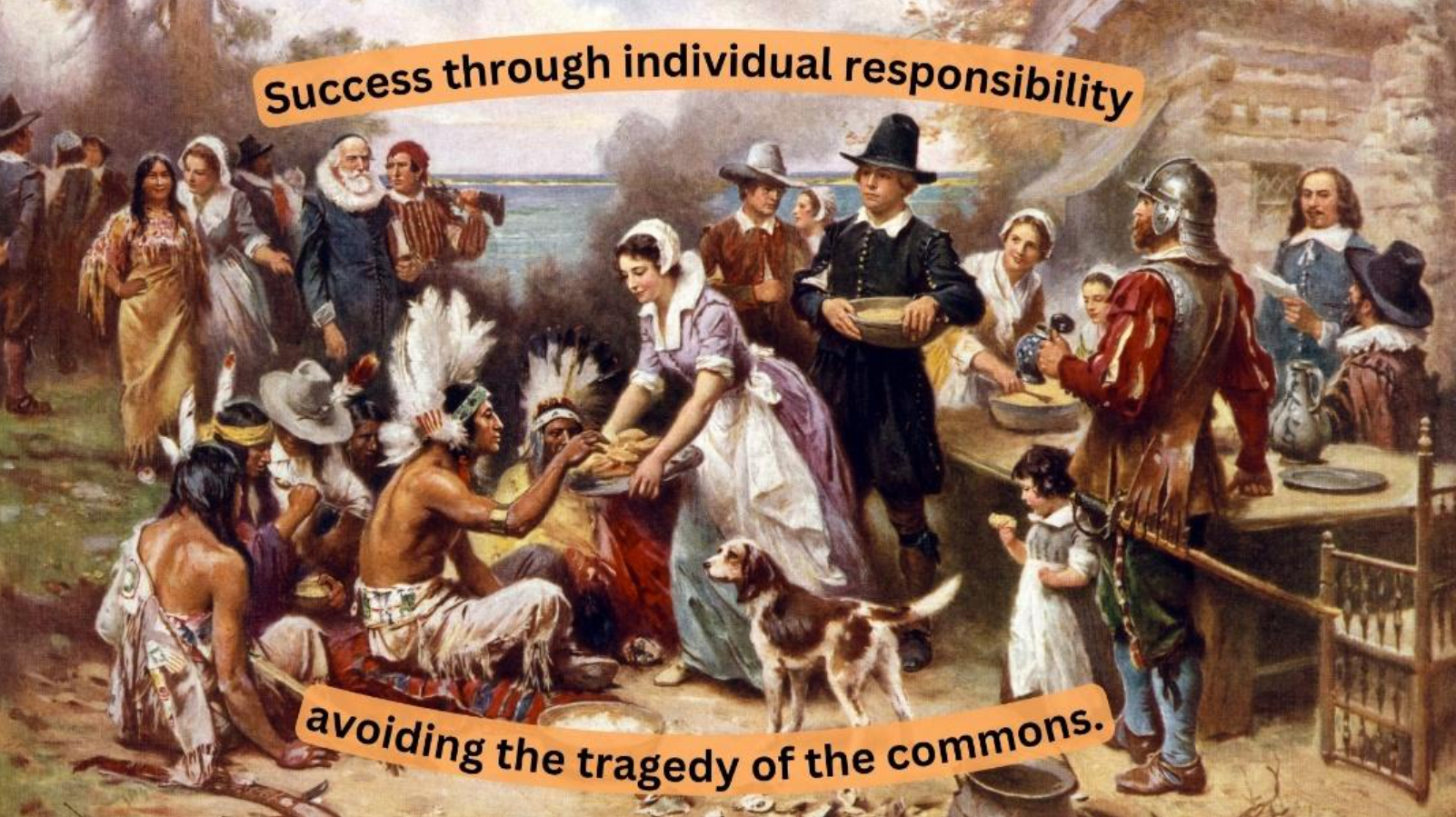Thanksgiving provides a perfect opportunity to teach the concept of the Tragedy of the Commons—a crucial idea in economics and environmental science. By examining the history behind the Pilgrims’ early years in America, educators can help students understand this phenomenon in a relatable and engaging way. Let’s explore how to incorporate the real story of Thanksgiving into your lessons, using materials from Stossel in the Classroom.
The Historical Context: A Lesson from the Pilgrims
Many students are familiar with the story of the Pilgrims’ first Thanksgiving—a harmonious feast shared with Native Americans. However, most don’t know the economic hardships that preceded it. The Pilgrims initially tried communal farming, where all the crops were grown together, and the harvest was shared equally among the settlers. Unfortunately, this well-intentioned system failed.
As discussed in the Stossel in the Classroom video The Real Story of Thanksgiving, the settlers quickly found themselves on the brink of starvation. Why? Because communal farming encouraged a lack of personal responsibility and hard work. Some settlers took more than their share, and others slacked off, thinking they would receive the same portion no matter how hard they worked, so why work too hard? This attitude led to a shortage of food and suffering during the Pilgrims’ first winter.
The Tragedy of the Commons: A Key Concept
This historical example of shared farming reflects what economists call the Tragedy of the Commons. The idea, as explained in the video, is that when resources are shared, individuals often act in their own self-interest, which can lead to the depletion or destruction of the resource. For example, in a communal pasture, ranchers may bring more and more cattle to graze, thinking they will benefit from it, even if it damages the land in the long run.
John Stossel’s videos, Happy Thanksgiving and The Real Story of Thanksgiving, explain this concept through simple experiments. In one experiment, participants could take coins from a shared “land.” The longer the coins were left, the more they grew in value. However, knowing that someone else might grab them first, participants rushed to take the coins, reducing the potential value for everyone. But when the land was divided into private sections, participants waited longer, knowing that the value would grow, and they would reap the benefits individually.
This mirrors what happened with the Pilgrims. Since the crops were shared, many settlers took what they could as soon as possible, instead of letting the plants mature, thinking others might take it first. Governor William Bradford realized that the problem was with the system. He switched from communal farming to private ownership, giving each family their own plot of land. Suddenly, the settlers had an incentive to work hard because they were directly responsible for their success. The result? A bountiful harvest and the first Thanksgiving.
Teaching the Tragedy of the Commons in the Classroom
Educators can use the story of the Pilgrims to help students understand how incentives and personal responsibility affect economic outcomes. Here’s how you can structure a lesson around this:
- Start with the Thanksgiving Myth: Begin by asking students what they know about the first Thanksgiving. Most will mention the feast with the Native Americans and the idea of sharing. Use this as a jumping-off point to introduce the concept of communal farming and its failure.
- Introduce the Tragedy of the Commons: Explain the basics of the Tragedy of the Commons. Use examples like overfishing, overgrazing, or pollution to show how shared resources can be misused.
- Connect the Pilgrims’ Story: Share the Pilgrims’ experience and how they moved from communal to private farming. Highlight how this change in incentives led to better results.
- Classroom Activity: Recreate Stossel’s experiment in class. Divide students into groups and have them “harvest” coins or other objects from a shared area. Then, switch to private sections and observe how their behavior changes. This hands-on activity can make the lesson more engaging and memorable.
- Discussion and Reflection: Ask students to reflect on modern examples of the Tragedy of the Commons, such as overfishing or deforestation. How do incentives and ownership impact how people treat shared resources?
Thanksgiving offers more than just a chance to celebrate. It provides a teachable moment about human behavior, incentives, and the importance of private property and personal responsibility. By using the story of the Pilgrims, educators can make the Tragedy of the Commons come alive in a way that resonates with students, showing them how economic principles impact real-life situations—even their favorite holidays.
Now please pass the turkey!



